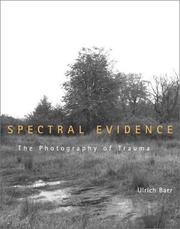| Listing 1 - 3 of 3 |
Sort by
|
Book
ISBN: 9782228910637 2228910635 Year: 2014 Publisher: Paris : Payot,
Abstract | Keywords | Export | Availability | Bookmark
 Loading...
Loading...Choose an application
- Reference Manager
- EndNote
- RefWorks (Direct export to RefWorks)
Approche psychologique des photographies de famille. L'auteure explique leur présence ou leur absence au sein des foyers, les raisons et les modalités de leur conservation, le besoin de les regarder pour renouer avec le passé, ce qu'elles révèlent de l'inconscient familial. ©Electre 2014
Photography --- Genealogy --- Photographie --- Psychogénéalogie --- Psychological aspects --- Psychic aspects --- Aspect psychologique --- fotografie --- portretfotografie --- fotografietheorie --- familiefoto's --- herinnering --- 77.01 --- 77.041 --- zelfportret --- psychologie --- fotografie en psychologie --- fotografie en psychoanalyse --- psychoanalyse --- Psychogénéalogie
Book
ISBN: 9780262013253 9780262516662 0262013258 0262516667 Year: 2011 Publisher: Cambridge, MA ; London Mit Press
Abstract | Keywords | Export | Availability | Bookmark
 Loading...
Loading...Choose an application
- Reference Manager
- EndNote
- RefWorks (Direct export to RefWorks)
Roland Barthes's 1980 book Camera Lucida is perhaps the most influential book ever published on photography. The terms studium and punctum, coined by Barthes for two different ways of responding to photographs, are part of the standard lexicon for discussions of photography; Barthes's understanding of photographic time and the relationship he forges between photography and death have been invoked countless times in photographic discourse; and the current interest in vernacular photographs and the ubiquity of subjective, even novelistic, ways of writing about photography both owe something to Barthes. Photography Degree Zero, the first anthology of writings on Camera Lucida, goes beyond the usual critical orthodoxies to offer a range of perspectives on Barthes's important book. Photography Degree Zero (the title links Barthes's first book, Writing Degree Zero, to his last, Camera Lucida) includes essays written soon after Barthes's book appeared as well as more recent rereadings of it, some previously unpublished. The contributors' approaches range from psychoanalytical (in an essay drawing on the work of Lacan) to Buddhist (in an essay that compares the photographic flash to the mystic's light of revelation); they include a history of Barthes's writings on photography and an account of Camera Lucida and its reception; two views of the book through the lens of race; and a provocative essay by Michael Fried and two responses to it.
77.01 --- fotografietheorie --- fotografie --- Barthes Roland --- semiotiek --- La chambre claire --- psychoanalyse --- fotografie en psychoanalyse --- boeddhisme --- fotografie en boeddhisme --- filosofie --- kunsttheorie --- 7.01 --- 77.01 Fotografie--Semiotiek van de fotografie. Theorie --- Fotografie--Semiotiek van de fotografie. Theorie --- Photographie. --- Kunstbeschouwing. --- Photographic criticism --- Photography, Artistic --- Photography --- Artistic photography --- Photography, Pictorial --- Pictorial photography --- Art --- Photography criticism --- Criticism --- Philosophy --- Aesthetics --- Barthes, Roland. --- Fotografie. --- Philosophie. --- Photographic criticism. --- Photography, Artistic. --- Philosophy. --- PHL-Research 13 --- kunst --- Critique photographique --- Photographie --- Photographie artistique --- Philosophie

ISBN: 0262025159 Year: 2002 Publisher: Cambridge, Mass. MIT Press
Abstract | Keywords | Export | Availability | Bookmark
 Loading...
Loading...Choose an application
- Reference Manager
- EndNote
- RefWorks (Direct export to RefWorks)
An original analysis of the parallels between the arrested moment in photography and in the traumatized psyche. In this remarkable contribution to photographic criticism and psychoanalytic literature, Ulrich Baer traces the hitherto overlooked connection between the experience of trauma and the photographic image. Instead of treating trauma as a photographic "theme," Baer examines the striking parallel between those moments arrested mechanically by photography and those arrested experientially by the traumatized psyche—moments that bypass normal cognition and memory. Taking as points of departure Charcot's images of hysteria and Freud's suggestion that the unconscious is structured like a camera, Baer shows how the invention of photography and the emergence of the modern category of "trauma" intersect. Drawing on recent work in the field of trauma studies, he shows how experiences that are inherently split between their occurrence and their remembrance might register in and as photographic images. In light of contemporary discussions of recovered memories and the limits of representing such catastrophes as the Holocaust, Baer examines photographs of artistic, medical, and historical subjects from the perspective of witnessing rather than merely viewing. He shows how historicist approaches to photography paradoxically overlook precisely those cataclysmic experiences that define our age. The photograph's apparent immunity to time is seen as a call for a future response—a response that is prompted by the ghostly afterlife of every photograph's subject. In a moving discussion of a rare collection of color slides taken by a Nazi official in the Lodz ghetto, Baer makes us aware that it is the viewer's responsibility to account for the spectral evidence embedded in every image.
psychotrauma's --- kritiek --- photography [process] --- fotografie --- Photography --- holocaust --- Photographic criticism. --- Psychic trauma --- 77.01 --- 616.89 --- Ulrich Baer --- psychiatrie --- fotografie en psychiatrie --- psychoanalyse --- fotografie en psychoanalyse --- traumatologie --- geneeskunde --- hysterie --- fotografie en hysterie --- Charcot Jean-Martin --- Freud Sigmund --- jodenvervolging --- nazisme --- fotografie en politiek --- Levin Meyer --- Levin Mikael --- Lodz --- ghetto's --- Polen --- Jablonski Dariusz --- 77.03 --- Fotografie--Semiotiek van de fotografie. Theorie --- Psychopathologie --- 77.01 Fotografie--Semiotiek van de fotografie. Theorie --- Photographic criticism --- Emotional trauma --- Injuries, Psychic --- Psychic injuries --- Trauma, Emotional --- Trauma, Psychic --- Psychology, Pathological --- Photography criticism --- Criticism --- Polemology
| Listing 1 - 3 of 3 |
Sort by
|

 Search
Search Feedback
Feedback About UniCat
About UniCat  Help
Help News
News